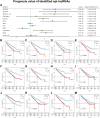Epigenetic dysregulated long non-coding RNAs in renal cell carcinoma based on multi-omics data and their influence on target drugs sensibility
- PMID: 39156959
- PMCID: PMC11327069
- DOI: 10.3389/fgene.2024.1406150
Epigenetic dysregulated long non-coding RNAs in renal cell carcinoma based on multi-omics data and their influence on target drugs sensibility
Abstract
Purpose: Epigenetic modifications play a crucial role in cancer development, and our study utilized public data to analyze which leads to the discovery of significant epigenetic abnormalities in lncRNAs, offering valuable insights into prognosis and treatment strategies for renal carcinoma.
Methods: Public data were obtained from the Cancer Genome Atlas (TCGA), International Cancer Genome Consortium (ICGC) and Gene Expression Omnibus (GEO) database. The analysis of the online public data was all completed in R software.
Results: We discovered a great number of epigenetic abnormalities of lncRNA in renal cancer, which is achieved by comparing the following modification and methylation of histone region changes on the promoter and enhancer of lncRNA: H3K27ac, H3K4me1, H3K4me3. As a result, 12 specific epigenetic disorders of lncRNA genes in renal cancer were identified. Finally, based on this lncRNA, we investigated the prognosis of renal cancer samples, among which 8 lncRNA can be seen as markers of prognosis in renal cancer, which had great prediction ability for ccRCC prognosis. Meanwhile, high risk score may pose response better to axitinib and nilotinib, but not sorafenib or sunitinib. Beyond, we observed an elevated level of risk score in immunotherapy non-responders. Further, biological enrichment and immuno-infiltration analysis was conducted to investigate the fundamental differences between patients categorized as high or low risk.
Conclusion: Our research improves the understanding in the function of epigenetic dysregulated long non-coding RNAs in renal carcinoma.
Keywords: ccRCC; epigenetic; lncRNAs; prognosis; sensitivity.
Copyright © 2024 Wang, Dou, Sun, Zheng, Wu, Liu and Tao.
Conflict of interest statement
The authors declare that the research was conducted in the absence of any commercial or financial relationships that could be construed as a potential conflict of interest.
Figures








Similar articles
-
Identification and Validation of 7-lncRNA Signature of Epigenetic Disorders by Comprehensive Epigenetic Analysis.Dis Markers. 2022 Feb 21;2022:5118444. doi: 10.1155/2022/5118444. eCollection 2022. Dis Markers. 2022. PMID: 35237359 Free PMC article.
-
Prognosis of clear cell renal cell carcinoma (ccRCC) based on a six-lncRNA-based risk score: an investigation based on RNA-sequencing data.J Transl Med. 2019 Aug 23;17(1):281. doi: 10.1186/s12967-019-2032-y. J Transl Med. 2019. PMID: 31443717 Free PMC article.
-
Construction of Competitive Endogenous RNA Network and Verification of 3-Key LncRNA Signature Associated With Distant Metastasis and Poor Prognosis in Patients With Clear Cell Renal Cell Carcinoma.Front Oncol. 2021 Mar 24;11:640150. doi: 10.3389/fonc.2021.640150. eCollection 2021. Front Oncol. 2021. PMID: 33869028 Free PMC article.
-
Identification and Validation of Cuproptosis-Related LncRNA Signatures in the Prognosis and Immunotherapy of Clear Cell Renal Cell Carcinoma Using Machine Learning.Biomolecules. 2022 Dec 16;12(12):1890. doi: 10.3390/biom12121890. Biomolecules. 2022. PMID: 36551318 Free PMC article.
-
A new CCCH-type zinc finger-related lncRNA signature predicts the prognosis of clear cell renal cell carcinoma patients.Front Genet. 2022 Sep 30;13:1034567. doi: 10.3389/fgene.2022.1034567. eCollection 2022. Front Genet. 2022. PMID: 36246657 Free PMC article.
References
-
- Bai J. Y., Jin B., Ma J. B., Liu T. J., Yang C., Chong Y., et al. (2021). Hotair and androgen receptor synergistically increase Gli2 transcription to promote tumor angiogenesis and cancer stemness in renal cell carcinoma. Cancer Lett. 498, 70–79. Epub 2020/11/07. 10.1016/j.canlet.2020.10.031 - DOI - PubMed
-
- Becker L. M., O'Connell J. T., Vo A. P., Cain M. P., Tampe D., Bizarro L., et al. (2020). Epigenetic reprogramming of cancer-associated fibroblasts deregulates glucose metabolism and facilitates progression of breast cancer. Cell. Rep. 31 (9), 107701. 10.1016/j.celrep.2020.107701 - DOI - PMC - PubMed
LinkOut - more resources
Full Text Sources
Research Materials

